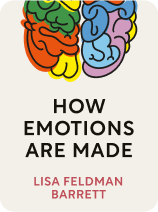

This article is an excerpt from the Shortform book guide to "How Emotions Are Made" by Lisa Feldman Barrett. Shortform has the world's best summaries and analyses of books you should be reading.
Like this article? Sign up for a free trial here.
What is mindfulness, according to Buddhism? How can using Buddhism and the concept of mindfulness help to manage your emotions?
The Buddhist concept of mindfulness has gained popularity recently thanks to its healing effects on your body and mind. In her book, How Emotions Are Made, psychologist Lisa Feldman Barrett explains why learning to use mindfulness in your daily life helps to relieve stress and balance your mood.
Keep reading to learn about Buddhism and mindfulness, according to Barrett’s findings.
What Is Mindfulness?
Mindfulness is a Buddhist concept that helps you to distinguish between emotions and physical sensations, and to recategorize your emotions. For example, if you’re about to give a speech and you feel nervous, you could deconstruct this emotion into its underlying physical sensations, such as sweaty hands and a fast-beating heart. You could then reconstruct it another way—as excitement for the opportunity to share your ideas with others, rather than dread about standing in front of a room full of strangers. In fact, studies show that students perform better on math tests when they recategorize anxiety as merely a sign that the body is coping.
Barrett indicates that Buddhist mindfulness meditation can help with distinguishing between thoughts and emotions, on the one hand, and physical sensations, on the other. Cultivating and experiencing awe—the feeling of being in the presence of something vastly greater than yourself—can also help you get some distance from yourself.
Buddhism and Managing Emotions With Mindfulness
Barrett alludes to the fact that the idea of “recategorizing” your emotions has its roots in Buddhism.
In fact, Buddhism has long recognized the importance of differentiating between negative feelings and the mental suffering that the human brain piles on top of those feelings. This is illustrated by the Buddhist concept of the two arrows, which instructs that when something bad happens to us, we are hit with the first “arrow” of emotional or physical pain. But the second arrow, we shoot ourselves: It is the mental suffering our thoughts create.
For example, we may feel unpleasant and agitated inside, but rather than sitting with and acknowledging those feelings, we may think, “I feel so awful! Why is this happening to me? Am I depressed? Am I sick? I can’t take this anymore!” If we can use the Buddhist concept of mindfulness to recognize that our thoughts are the second arrow, we can remove that additional layer of pain, and be left with simple discomfort.
In Radical Acceptance, psychologist and Buddhist Tara Brach advises dealing with negative feelings by using the two aspects of radical acceptance: recognition and compassion. Recognition, which Buddhists often call mindfulness, is the practice of simply observing your feelings as they arise in the moment. Compassion means responding to your own feelings as you would to a beloved friend. Rather than berating yourself for your negative feelings, respond to them with kindness and care.

———End of Preview———
Like what you just read? Read the rest of the world's best book summary and analysis of Lisa Feldman Barrett's "How Emotions Are Made" at Shortform.
Here's what you'll find in our full How Emotions Are Made summary:
- A deep dive into what emotions really are and where they come from
- How some cultures have different emotions than others
- The difference between feelings and emotions






